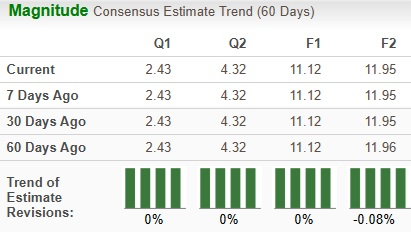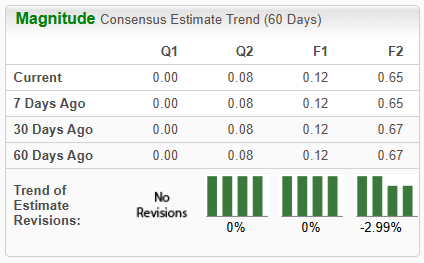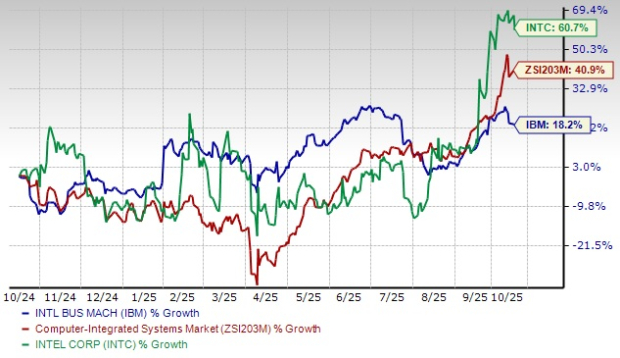|
|
|

|
|||||

|
|
International Business Machines Corporation IBM and Intel Corporation INTC are tech legacy firms pivoting toward cutting-edge growth areas, including cloud computing and AI (artificial intelligence) workloads, semiconductor chips and patent-driven innovations. IBM offers cloud and data solutions that aid enterprises in digital transformation. In addition to hybrid cloud services, the company provides advanced information technology solutions, computer systems, quantum computing and supercomputing solutions, enterprise software, storage systems and microelectronics.
Intel, reportedly the world’s largest semiconductor company and primary supplier of microprocessors and chipsets, is gradually reducing its dependence on the PC-centric business by moving into data-centric businesses, such as AI and autonomous driving. The foundry operating model is a key component of the company's strategy, designed to reshape operational dynamics and drive greater transparency, accountability and focus on costs and efficiency.
Let us delve a little deeper into the companies’ competitive dynamics to understand which of the two is relatively better placed in the industry to warrant a place in your investment portfolio.
IBM is poised to benefit from healthy demand trends for hybrid cloud and AI, which drive the Software and Consulting segments. The company’s growth is expected to be aided by analytics, cloud computing and security in the long term.
With a surge in traditional cloud-native workloads and associated applications, along with a rise in generative AI deployment, enterprises are currently managing huge cloud workloads. This has resulted in heterogeneous, dynamic and complex infrastructure strategies, which have led firms to undertake a cloud-agnostic and interoperable approach to highly secure multi-cloud management, translating into a healthy demand for IBM hybrid cloud solutions.
In addition, the buyout of HashiCorp has significantly augmented IBM’s capabilities to assist enterprises in managing complex cloud environments. HashiCorp’s tool sets complement IBM Red Hat’s portfolio, bringing additional functionalities for cloud infrastructure management and bolstering its hybrid multi-cloud approach.
Despite solid hybrid cloud and AI traction, IBM is facing stiff competition from Amazon.com, Inc.’s AMZN AWS and Microsoft Corporation’s MSFT Azure. Increasing pricing pressure is eroding margins, and profitability has trended down over the years, barring occasional spikes. The company’s ongoing, heavily time-consuming business model transition to the cloud is a challenging task. Weaknesses in its traditional business and foreign exchange volatility remain significant concerns.
Intel is investing to expand its manufacturing capacity to accelerate its IDM 2.0 (Integrated Device Manufacturing) strategy. The company is undertaking various strategic decisions to gain a firmer footing in the expansive AI sector. It recently previewed Intel Core Ultra series 3 processor (code-named Panther Lake) and Xeon 6+ (code-named Clearwater Forest). Manufactured in a new, state-of-the-art factory in Chandler, AZ, both products are built on Intel 18A, the most advanced semiconductor process in the United States. Panther Lake is designed to power a broad spectrum of consumer and commercial AI PCs, gaming devices and edge solutions. Clearwater Forest is an E-core server processor that enables business enterprises to scale workloads, reduce energy costs and power more intelligent services. While Panther Lake will be available in the broad market from January, Clearwater Forest is slated to be launched in the first half of 2026.
Intel's innovative AI solutions are set to benefit the broader semiconductor ecosystem by driving down costs, improving performance and fostering an open, scalable AI environment. The company has received $7.86 billion in direct funding from the U.S. Department of Commerce for its commercial semiconductor manufacturing projects under the U.S. CHIPS and Science Act.
The funds will support Intel in advancing critical semiconductor manufacturing and advanced packaging projects in Arizona, New Mexico, Ohio and Oregon, likely paving the way for innovation and growth. Intel has secured a $5 billion investment from NVIDIA Corporation NVDA to jointly develop cutting-edge solutions that are likely to play an integral role in the evolution of the AI infrastructure ecosystem. In August 2025, Softbank also invested $2 billion in Intel to propel AI research and development initiatives that support digital transformation, cloud computing and next-generation infrastructure.
However, Intel derives a significant part of its revenues from China. As Washington tightens restrictions on high-tech exports to China, Beijing has intensified its push for self-sufficiency in critical industries. This shift poses a dual challenge for Intel, as it faces potential market restrictions and increased competition from domestic chipmakers. The company is also lagging behind in the GPU and AI front compared to peers such as NVIDIA and AMD. Leading technology companies are reportedly piling up NVIDIA’s GPUs to build clusters of computers for their AI work, leading to exponential revenue growth.
The Zacks Consensus Estimate for IBM’s 2025 sales implies a year-over-year rise of 6.4%, while that for EPS indicates growth of 7.7%. EPS estimates have remained static over the past 60 days.

The Zacks Consensus Estimate for Intel’s fiscal 2025 sales suggests a year-over-year decline of 2.2%, while that for EPS implies a rise of 192.3%. The EPS estimates have remained static over the past 60 days.

Over the past year, IBM has gained 18.2% compared with the industry’s growth of 40.9%. Intel has gained 60.7% over the same period.

Intel looks more attractive than IBM from a valuation standpoint. Going by the price/sales ratio, IBM’s shares currently trade at 3.71 forward sales, higher than 2.92 for Intel.

Both IBM and Intel carry a Zacks Rank #3 (Hold). You can see the complete list of today’s Zacks #1 Rank (Strong Buy) stocks here.
Both companies expect their sales to improve in 2025. IBM has shown a relatively steady revenue growth for the past few years, while Intel has been experiencing a decline. However, in terms of price performance, Intel has outperformed IBM. Intel is also trading relatively cheaply compared with IBM.
Nevertheless, with a stable free cash flow and software-driven recurring revenues leaning toward enterprise SaaS/AI transformation, IBM appears to be comparatively better placed than Intel. Consequently, IBM seems to be a better investment option at the moment.
Want the latest recommendations from Zacks Investment Research? Today, you can download 7 Best Stocks for the Next 30 Days. Click to get this free report
This article originally published on Zacks Investment Research (zacks.com).
| 24 min | |
| 30 min | |
| 1 hour | |
| 3 hours | |
| 3 hours | |
| 3 hours | |
| 4 hours | |
| 4 hours | |
| 4 hours | |
| 5 hours | |
| 7 hours | |
| Dec-12 | |
| Dec-12 | |
| Dec-12 | |
| Dec-12 |
Join thousands of traders who make more informed decisions with our premium features. Real-time quotes, advanced visualizations, backtesting, and much more.
Learn more about FINVIZ*Elite